The Willian Wyon Pattern 8 Reales
by Kent Ponterio
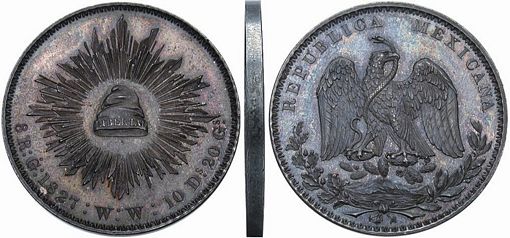
1827 Guanajuato Pattern 8 Reales
(image courtesy of Richard Ponterio
Among the most classic designs of all Mexican 8 Reales patterns are those designed at the Royal Mint by the famous English engraver William Wyon. The story of these coins is an interesting saga that spans nearly six decades and involves three different mints, Guanajuato, Alamos and Hermosillo. Our story begins with the mint of Guanajuato which began operations during the War of Independence as a provisional mint equipped with less than standard machinery. The production of coinage from this facility was sub standard in comparison to well-equipped mints such as Mexico City.
Shortly after Mexico gained its independence, the mint of Guanajuato was leased to the Anglo Mexican Mint Association. This British firm was closely related to the Anglo Mexican Mining Association, which began serious mining operations in the region in the 1820s. They acquired the mint as a means of refining and minting silver from their mining operations in the region. It became immediately apparent to the Anglo Mexican Mint Association that the facilities in Guanajuato were in dire need of modernization. It is important to note that both the mint and the mining operations in this region were controlled by English firms. For this reason, the natural choice for purchasing minting machinery was through Matthew Boulton and the Soho Mint.
The Anglo Mexican Mint Association took control of the Guanajuato mint in June of 1825. By August of that year negotiations had already begun to acquire new equipment from England. On 18 August a request was made for the estimated costs of a package consisting of four coining presses, eight punch presses for making planchets, a die multiplying press, as well as various other items necessary for the minting of coinage. Although state-of-the-art-steam powered coining presses were available at the time, specific requests were made for presses that could be adapted to either steam or horsepower since the scarcity of fuel (namely coal) in Guanajuato, made the operation of a steam press impractical. It is important to note that the original request for machinery did not include or mention coining des or hubs (this request came later).
Inevitably, the original request for machinery proved too ambitious for the Anglo Mexican Mint Association and a more modest order was placed. The second request was put together consisting of two coining presses, three punch presses for making planchets, one milling machine and a die multiplying press. All of the new equipment was to be operated by hand rather than with steam power. The request was granted and machinery was shipped to Guanajuato in October of 1827. The dies and pattern coinage are another story.
On 4 March 1826, an official from the Anglo Mexican Mint Association made an inquiry with the Soho mint regarding the purchase of master punches for the purpose of producing dies for the Guanajuato mint. In doing so, the Anglo Mexican Mint Association as well as the Soho mint crossed the line of legality. In accordance with Mexican law, all tools used in the creation of coining dies were to be directly acquired from the Mexico City mint. During this period, the Mexico City mint would send out master dies to the branch mints where the dies were then made locally. This proved to be an expensive and time consuming process. The Anglo Mexican Mint Association’s solution to this was to have the Soho mint produce dies and hubs. This would save them a great deal of time as well as a tidy sum of money.
The task of engraving the dies was given to William Wyon, one of the most talented and noted engravers ever to work in England. Although the design elements remained the same as those of other Mexican mints, the artistic style of Wyon’s work was dramatically different. The workmanship is nothing short of spectacular for the time with its neatly detailed design done in the neoclassical style for which Wyon was famous. The dies are remarkably well executed, the lettering used in both the obverse and reverse legends are neatly cut and precise. Struck with a medallic die axis; the piece bears a plain edge and has a very sharp upset rim with ornate denticles struck with the care and precision that is more reminiscent of contemporary English medals. They were undoubtedly struck with the state-of-the-art steam powered coining presses available at the Royal Mint in London. In fact, ButtreyT.V. Buttrey & Clyde Hubbard, A Guide Book Of Mexican Coins 1822 to Date states that the patterns were struck in London and the coins and dies were then sent to Mexico in 1827.
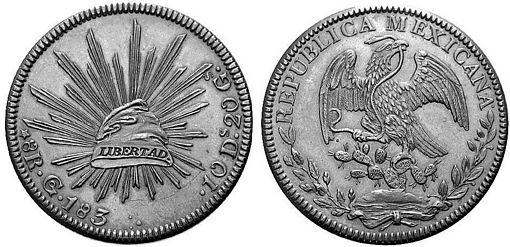
Pattern / trial strike from unfinished Soho mint die’ for the Guanajuato mint.
The second die style ordered by the Anglo Mexican Mint Association
(image courtesy of Richard Ponterio)
This is where the story takes an interesting turn. As previously mentioned, hubs and die making materials were required by law to be acquired directly from the Mexico City mint. As fate would have it, the dies and coins were considered illegal contraband and seized by customs agents at the port of Veracruz while attempting to enter Mexico. Surely the artistic beauty of the dies was one of their condemning factors as they were easily recognizable as not being a product of the Mexico City mint. Although a major setback, this unfortunate set of events did not stop the Anglo Mexican Mint Association from purchasing further dies and hubs from Soho. In 1829 the firm shipped an actual pair of Guanajuato dies to England for the purpose of replication. In the request it was stated that the dies must be virtually identical to the Mexico City product, however of a more refined style and quality. Production of the new dies began 5 January 1830. Coins of this new die style were produced at Guanajuato from 1830 until 1843.
So what became of the original dies and hubs designed by William Wyon that were confiscated in Veracruz? One would speculate that such illegal contraband would have been destroyed after seizure; however this was not the case. In fact, it has long been known that either the dies or hubs later resurfaced in Hermosillo more than half a century later and were used to produce patterns dated 1882. What remained unclear is where were they for the previous 50+ years.
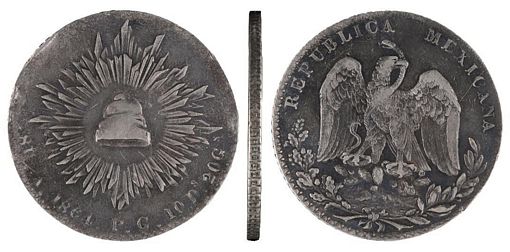
1864 Alamos Pattern 8 Reales of the William Wyon design
The discovery of an Alamos pattern dated 1864 sheds some light on the subject. Totally unpublished in any numismatic reference and believed to be unique, the existence of this pattern only recently came to light. It was brought to us through one of our foreign contacts who acquired it as part of a larger collection in Europe. Clearly it was manufactured using either repurposed dies intended for Guanajuato, or by manufacturing new dies using the original William Wyon hubs. This pattern dated 1864 has a unique claim of being the first 8 Reales pattern of the Alamos mint, as it was produced the very first year of 8 Reales production. Also unique is the fact that it is the only known pattern for this branch mint from any period. The legend has been neatly placed below the cap and ray, having been executed with what appears to be the punches used to produce 2 Reales. The letters PG for Pascual Gaxiola, the assayer at the Alamos mint in 1864, are present after the date. The strike and edge reeding are quite different than the 1827 English made pattern for Guanajuato which as mentioned are plain edge and produced with a stem press. The Alamos piece is more consistent with later Hermosillo pieces showing evidence of screw press manufacturing and the usage of an edge milling machine. Thus, the present coin was unquestionably produced in Mexico rather than England.
The circulated condition of this piece perhaps suggest its use as a pocket piece. It seems unlikely that a coin of such dramatically different style would have remained in circulation long enough to sustain this degree of wear. Being that the coin surfaced in Europe, along with the fact that the mint was contracted to a foreign company leaves one to wonder if this piece belonged to some foreign entrepreneur who held a position at the mint and carried it as a keepsake or memento. This part is best left to the imagination
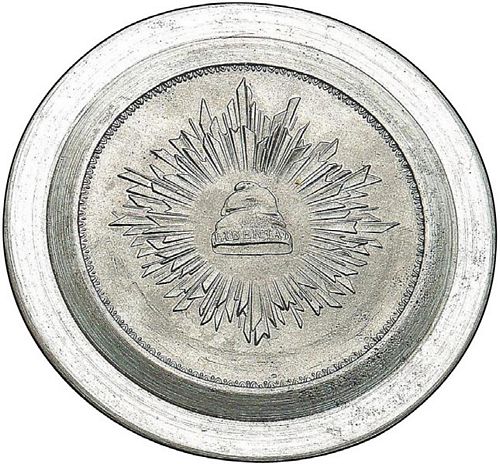
Original William Wyon master hub
Banco de México Collection
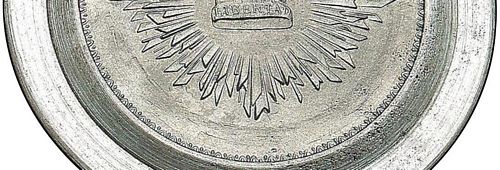
Original William Wyon master hub
Enlargement of defaced legend
Banco de México Collection
Further insight can be gained by examining the original master hub designed by William Wyon (now housed in the Banco de México collection). Clear evidence of intentional defacement is seen from 9 to 3 o’clock to remove the legend intended for Guanajuato. This explains why the piece produced by the Alamos mint and later pieces produced by the Hermosillo mint differ in their legend arrangement and punch size. It is unclear (at least to me) how or when the Banco de México came to be in possession of the Wyon hub. It is plausible that the hub was shipped to Mexico City in the 1890s with other dies and equipment after the Hermosillo mint closed in 1895 and has remained with the Banco de México since that time. What remains unclear is exactly how the hubs which were seized by customs officials in Veracruz made their way some 1,200+ miles to the state of Sonora more than three decades after they were confiscated. Perhaps the most plausible explanation is that somehow during the French intervention the hubs were removed from where they were being stored in Veracruz. The timeline would seem to fit as the French began their bombardment of Veracruz in early 1863, and the hubs were used in Alamos the following year. The pristine condition of the hubs suggests that they may have been still packed in the original white wax used during shipping from England. Certainly they were covered in some substance to prevent oxidation. Regardless, serviceable hubs for coinage manufacture would have been worth a tidy sum of money on the open market.
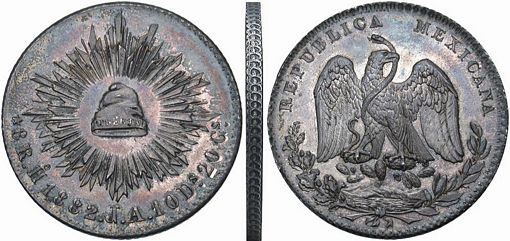
1882 Hermosillo Pattern 8 Reales
(image courtesy of Richard Ponterio)
The 1882 Hermosillo patterns are much like the 1864 Alamos pattern in terms of how they were manufactured. Both were produced with a screw press after the planchets were edged with milling machinery. In fact the edge of the 1882 Hermosillo is identical to regular circulation issue from this year. The legend below the cap and rays was produced with identical punches used on contemporary Hermosillo 8 Reales between 1876 and 1880. The assayer’s initial “J.A.” are consistent with that of Jesus Acosta, the Assayer at the Hermosillo mint from 1877 to 1883.
There are identical defects within the dies, which appear on coins from all three mints. Most noticeable is a small raised dot directly to the left of the liberty cap. This can also be seen on the 1864 Alamos; however, is slightly less noticeable due to the coin being circulated. Exactly how the hubs went from from Alamos to Hermosillo seems a bit easier to comprehend. Both mints are located in Sonora and both were leased either in full or part to Robert R. Symon of the English firm Symon & Cia during the period these coins were produced.
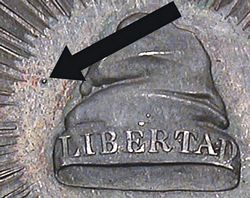
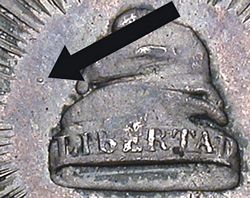
Die defect on 1827 Go Die defect on 1882 Ho
(imagies courtesy of Richard Ponterio)
